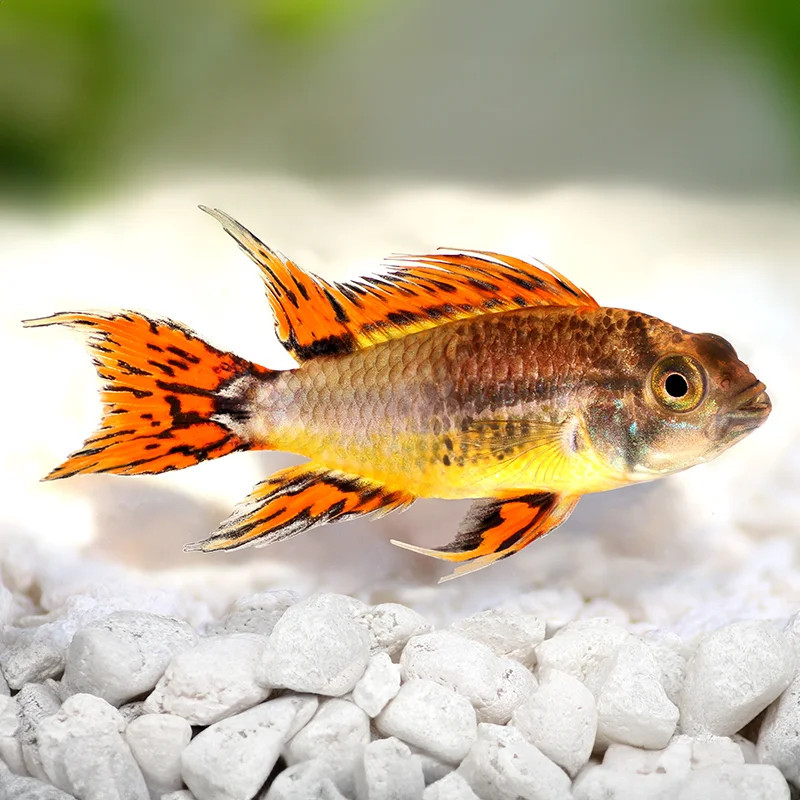Stocks Available
Flame Red Dwarf Agassizii
SKU:128914
APISTOGRAMMA AGASSIZII
1.75-2.25 INCH

Stock Available
Introduction: Species: Apistogramma cacatuoides Common Names: Dwarf Cockatoo Cichlid, Cockatoo Dwarf Cichlid Natural Habitat: Native to the slow-moving waters of the Amazon Basin in South America, particularly in regions of Peru and Colombia. They are typically found in heavily planted areas with soft substrates, where they can hide among the vegetation. Physical Characteristics: Appearance: The Dwarf Cockatoo Cichlid is known for its stunning coloration and unique fin structure. Males display bright yellow to orange colors with dark vertical bands, while females are generally smaller and more subdued in color but often feature a striking blue or turquoise hue on their cheeks. The males also have elongated dorsal fins resembling a cockatoo's crest. Size: Grows to about 3-4 inches (7.5-10 cm) in length. Lifespan: Typically lives for 3-5 years with proper care. Habitat Requirements: Tank Size: A minimum of 20 gallons is recommended for a small group; larger tanks are preferred for breeding pairs or to provide ample swimming space. Water Conditions: Temperature: 75-82°F (24-28°C). pH: 6.0-7.5 (soft to slightly acidic). Hardness: Soft water (2-12 dGH). Aquascaping: Provide a densely planted aquarium with plenty of hiding spots using driftwood, rocks, and dense vegetation. Open swimming areas are also essential for their comfort. Diet: Primary Diet: Omnivorous; in the wild, they feed on small invertebrates, insects, and plant matter. Supplemental Feeding: In captivity, offer high-quality cichlid pellets or flakes, supplemented with frozen or live foods such as brine shrimp, bloodworms, and finely chopped vegetables. Feeding Frequency: Feed small portions 1-2 times a day for optimal health, ensuring any uneaten food is promptly removed to maintain water quality. Compatibility: Temperament: Generally peaceful but can be territorial, especially during breeding. Suitable Tank Mates: Compatible with other small, peaceful fish such as Tetras, Rasboras, and small livebearers. Incompatibilities: Avoid larger, aggressive species that may bully or stress the Dwarf Cockatoo Cichlid. Care Level: Difficulty: Moderate; requires stable water parameters and regular maintenance to thrive. Health Monitoring: Monitor for signs of disease, especially stress-related issues and common parasites. Regular water changes and good filtration are essential for their overall health. Breeding: Breeding in Captivity: Breeding is relatively easy with suitable conditions; they are mouthbrooders. Spawning: The female lays eggs in a hidden area, often on flat surfaces, and will guard the eggs and fry after they hatch. Economic Considerations: Market Demand: The Dwarf Cockatoo Cichlid is popular among freshwater aquarium enthusiasts due to its vibrant colors and interesting behavior. Wholesale/Retail Pricing: Prices can vary but are generally affordable, making them accessible for many aquarists. Sustainability and Conservation: Wild Population: While not currently endangered, habitat degradation and pollution can threaten their natural populations. Aquaculture Efforts: Often bred in captivity to meet market demand and reduce reliance on wild populations. Regulations: Compliance with local and international regulations regarding the trade of freshwater fish is essential for conservation. Conclusion: The Dwarf Cockatoo Cichlid is a vibrant and charming addition to freshwater aquariums, valued for its striking appearance and engaging behavior. Their care requirements and breeding habits make them suitable for both novice and experienced aquarists. With proper attention to their habitat and dietary needs, Dwarf Cockatoo Cichlids can thrive, adding beauty and personality to any aquarium setting.
Data sheet
16 other products in the same category:
Customers who bought this product also bought: